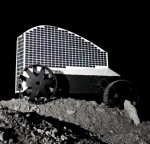Astrobotic Technology Inc., a Carnegie Mellon University spinoff, has unveiled a prototype of a solar powered robot that will search for water ice at the moon’s poles.
Polaris will be able to bore one metre into the moon’s surface and be able to work in shadowy conditions.
“It is the first rover developed specifically for drilling lunar ice,” said William Whittaker, Astrobotic CEO and founder of the Field Robotics Center at CMU’s Robotics Institute.
The rover will need to operate as close to the dark poles as possible, but not so far that into the darkness it can’t use solar arrays for power. Polaris has three large solar arrays capable of generating 250 watts on average. The solar cells are arranged in a vertical position to capture light from low on the horizon.
Polaris is 1.68 metres high, 2.13 metres wide and 2.4 metres long. It can travel at around 1 kilometre an hour. Weighing 150 kilograms, Polaris can carry a payload of up to 70 kilograms, plus a drill. The vehicle has been designed to negotiate rough terrain.
The lunar day lasts about 14 Earth days and of those, only 10 will be suitable for water prospecting at the poles. The Astrobotic team believes Polaris could drill 10 to 100 holes during that time and if it survives the long, freezing lunar nights, the mission could be extended indefinitely.
A substantial amount of water ice is thought to exist at the lunar poles, which could be used to sustain humans and provide fuel and oxygen for future expeditions.
Polaris will be launched from Cape Canaveral atop a SpaceX Falcon 9 launch vehicle. The company, in partnership with CMU, has its eyes set on the Google Lunar X Prize. $30 million in prizes are available to the first privately funded teams to safely land a robot on the surface of the Moon, have that robot travel half a kilometre over the lunar surface and send video, images and data back to Earth.












































